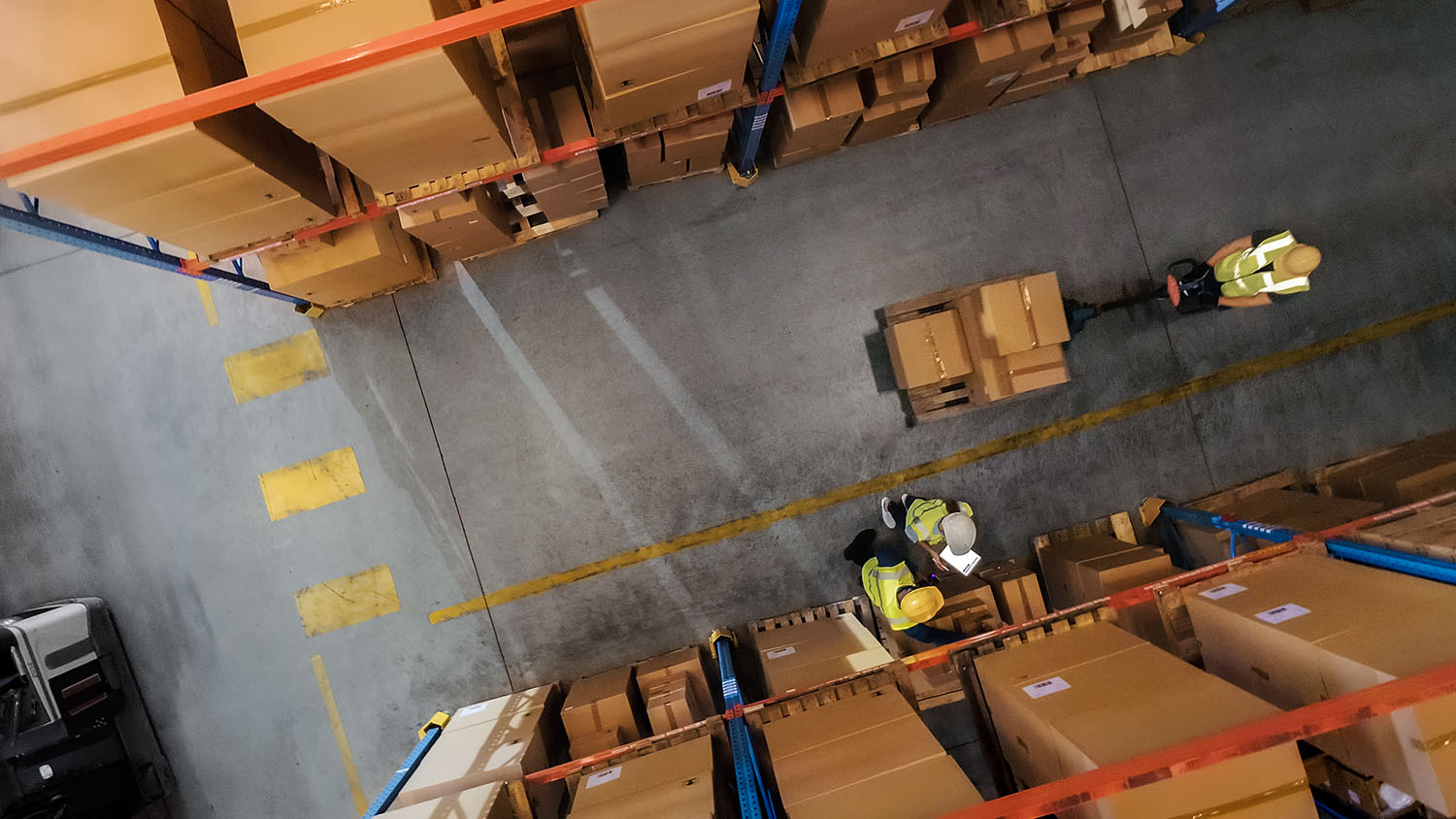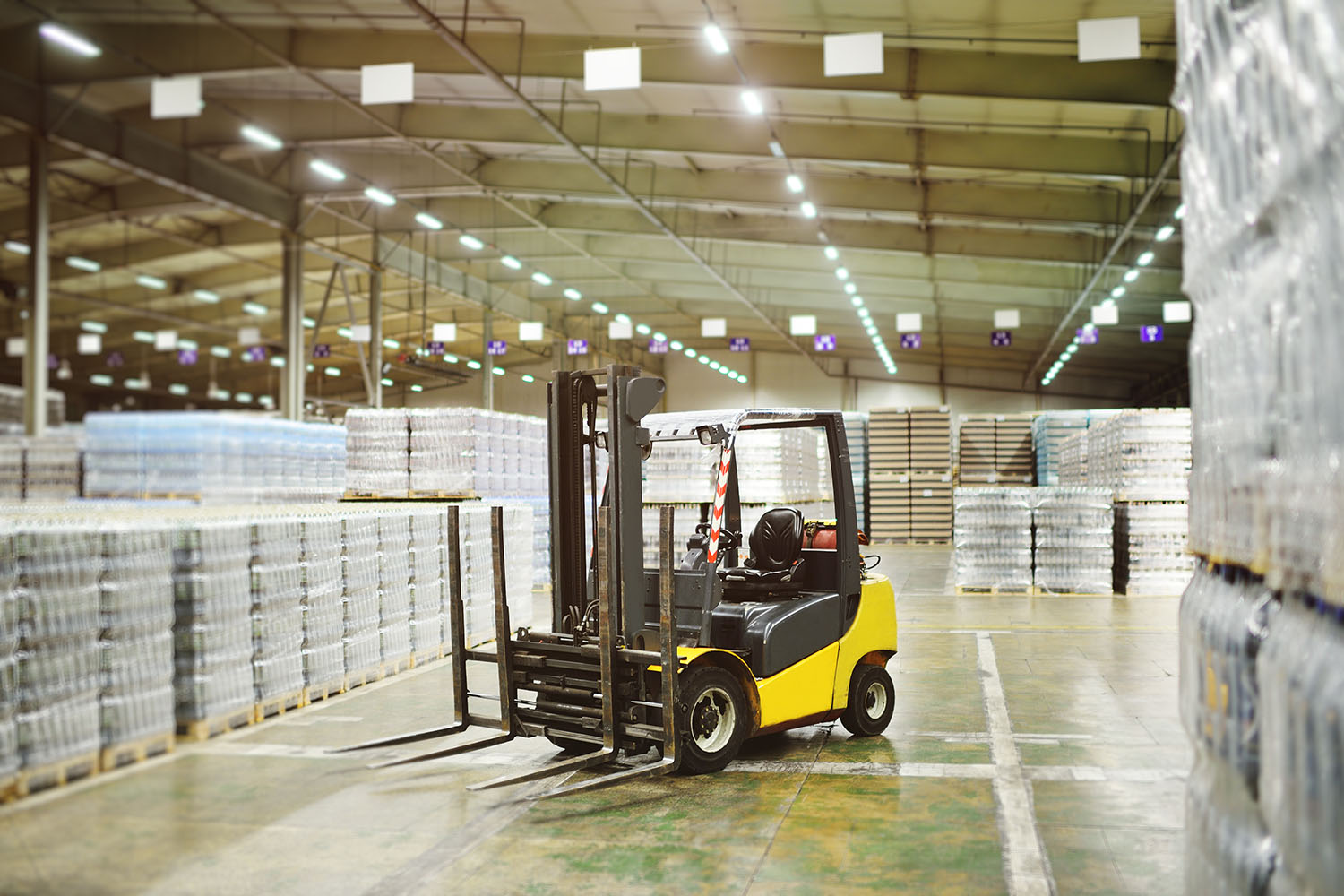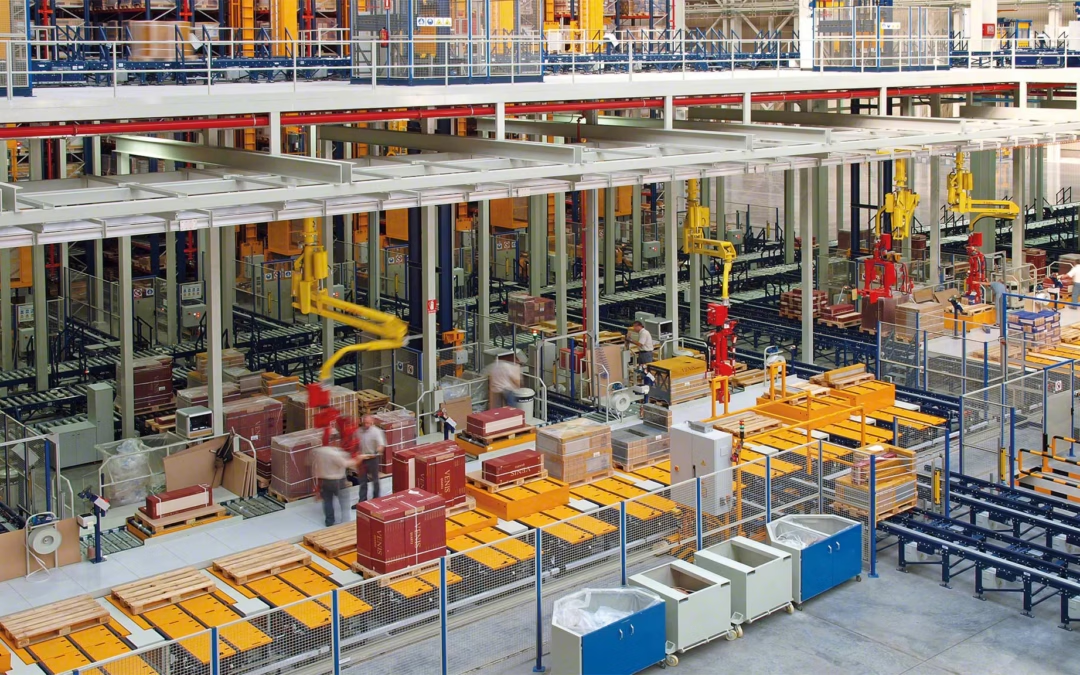Modern picking automation combines robotics or mechanizations with warehouse management systems (WMS) to streamline item retrieval and improve warehouse operations. This integration of robots, mechanized systems, and smart software helps 3PLs and other big warehouses handle large inventories for multiple clients by streamlining receiving, order picking, sorting, and quality inspection.
According to a study by Gartner, 75% of warehouses will adopt cyber-physical automation (CPS) by 2027. CPS refers to the combining of physical and digital components to improve operational workflows.
In this article, we will discuss how automated warehouse picking works, its benefits, and underlying challenges.
We’ll also cover how to nail operational workflows, like organizing storage and order picking, with cloud-based WMS software to synchronize automated tools like robotic arms and automated guided vehicles (AGVs) for better coordination, storage space use, and picking accuracy across all stations.
What is Automated Warehouse Picking?
Automated warehouse picking leverages robotics and semi-robotic technologies like pick-to-light and voice command systems to retrieve and deliver items from inventory. Advanced tools, such as Warehouse Management Systems (WMS), enable smart picking strategies that optimize both robotic and human workflows.
Unlike traditional manual methods that rely heavily on labor for tasks like storage, order picking, and sorting, automation integrates intelligent algorithms and real-time data analytics to improve accuracy and speed, whether assisting workers or directing robotic systems.
How Does Automated Warehouse Picking Work?
Here’s how automated warehouse picking works using a warehouse management system in a basic facility:
- Order Received: The WMS receives customer orders and identifies them via barcodes.
- Task Assignment: The software maps out the shortest routes for you and decides the best way to handle orders, whether by grouping them in a batch or by demand.
- Item Verification: Human pickers collect each item using scanners to verify quality, while some warehouses use robotics to handle repetitive picking tasks with precision.
- Data Updates: The WMS software tracks all picked items throughout the process in real time.
- Sorting and Delivery: Either robotic arms or human pickers sort items by individual order and send them to packing stations or consolidation zones for shipping.
Types of Automated Warehouse Picking Systems
There are 6 types of automated warehouse picking systems that you should know:
1. Goods-to-Person (G2P)
In Goods-to-person systems, automated tools like robotic arms, shuttles, carousels, or conveyors pick and drop items from the inventory to the workstation where the worker sorts them by individual order and sends them off for packaging and shipping.
Good-to-Person is best for: 3PL warehouses with large inventories and high-demand SKUs (stock-keeping units).
See how advanced 3PL WMS solutions like Da Vinci match your warehouse’s unique needs for inventory management and a faster picking process.
2. Robotics-Based Picking
Robotics picking can fully or partially automate storage, picking, and packing based on your warehouse setup. Systems like Autonomous Mobile Robots (AMRs) or Automated Guided Vehicles (AGVs) pick and drop items from one storage container to another until it’s packed for shipping. The workers only do quality checks for accuracy using WMS software.
For example, If your warehouse uses AGVs, you can pair them with sensors and cloud-based WMS features to check if the picked items are placed in the correct bins, track stock levels in real-time, and optimize inventory storage.
Robotics-based picking is best for: Warehouses that want to modernize their operations with robotics systems to improve accuracy and speed.
3. Pick-to-Light Systems
Pick-to-light or put-to-light systems use lights or visual cues to guide workers in a large storage area. Here’s how it works: first, you scan the order’s barcode and the sensors light up each item container with a digital quantity display.
The pickers collect items from each container while pressing the confirm button to update the order status. These systems are quite advanced and pair well with WMS software to further simplify your warehouse picking operations by giving real-time updates.
Pick-to-light systems are best for: Warehouses with lightweight items for faster single-order picking.
4. Voice Picking Systems
Voice-picking systems use voice commands to assist workers in locating and picking items. Workers pick as they hear order instructions on their microphone headsets, speeding up the packing and shipping process.
Voice-picking systems are best for: Warehouses with high-demand items that want to shorten their picking process.
5. Automated Storage and Retrieval Systems (ASRS)
Automated Storage and Retrieval Systems (ASRS) are software-controlled systems that automatically store and retrieve goods in a huge inventory warehouse. Machines like cranes, shuttles, or robots pick pallets or containers from shelves (can be up to 10 feet tall) and unload them on conveyors that transfer them to shipping counters.
ASRS systems, when combined with WMS software, use smart intelligence to organize storage according to your warehouse demands for picking precision, accuracy, and speed.
ASRS is best for: Big wholesale warehouses that sell and ship items in bulk.
6. WMS-Automated Picking Methods
Warehouses use several different types of picking algorithms to increase accuracy for order-picking decisions, all automated by the WMS:
- Batch picking: Grouping items in a batch and then sorting them by individual order.
- Wave picking: Items are picked in batches (waves) based on demand or delivery schedules.
- Cluster picking: Sorting and collecting items simultaneously.
- Single-order picking: Items are collected individually for each order.
For example, Da Vinci’s WMS may use wave picking in a high-demand warehouse to store items by product characteristics (type, demand, or size) for easy retrieval.
Order-picking methods are best for: Warehouses with high-volume orders with repetitive or irregular workflows.
Benefits of Automated Warehouse Picking
Some of the benefits of automated warehouse picking systems include:
Optimize Order Picking Accuracy
Automated warehouse picking leverages advanced algorithms that improve your picking process by organizing your storage with shorter routes. These algorithms help minimize human picking errors like item misplacement with precise data.
Coordinate Systems
A cloud-based WMS coordinates between robotic pickers, conveyor systems, other automation, and manual processes. The software provides real-time updates to both workers and automated systems about order status, inventory location, and picking priorities. For example, when using RFID tracking, the system instantly verifies picked items and updates inventory counts, while simultaneously directing robots or human pickers to their next tasks.
Improve Picking Speed
Automated tools like WMS speed up your picking process by integrating intelligent systems. They can assign high-demand items closer to picking zones, command robotics for item retrievals, and give workers easy-to-read picking instructions for quicker collection.
Cost Reduction
Automated systems cut down operational costs and workforce load in large warehouses. For example, with ASRS, you can shelf items vertically until the full ceiling height of your warehouse and use automated retrieval systems like robotic arms or conveyor lifts for picking. This saves floor space and time needed for manual storing.
Strengthen Customer Satisfaction
Automated tools speed up shipping to end-consumers for 3PL warehouses. When the end customers receive goods on time, they are more likely to buy again.
Case Study: How a Tool Manufacturer SAM Outillage Used Automated Warehouse Picking to Increase Productivity
A Saint-Étienne-based hand tool manufacturer SAM Outillage had a catalog of 10,000 SKUs across multiple product categories. The company aimed to boost its storage capacity by 50% and manage its logistics operations effectively.
Problem: Outdated Warehousing
Before adopting the automated system, SAM Outillage faced the following problems:
- Inefficient Storage Utilization: The warehouse’s clogged storage couldn’t accommodate its growing inventory.
- High Travel Times for Operators: Operators walked 10–12 kilometers daily to locate and pick SKUs, causing delays in order fulfillment.
- Inadequate Order Accuracy: Manual processes led to picking errors, affecting their end-customer satisfaction.
- Slow Processes: SAM Outillage needed a faster system to achieve 24-hour delivery for its 10,000 SKUs.
Solution: Implementing Automated Warehouse Picking
SAM Outillage worked with a partner to implement automated solutions in its ecosystem:
- Automated Warehouse for Boxes: The manufacturer used double-deep racking and three automated aisles to increase its storage for 19,448 boxes, consolidating 80% of SKUs into a high-density space.
- WMS Integration: Integrated warehouse management system to customize its stock management with real-time inventory tracking.
- Pallet Racking: Adopted palletization to store bulky items using tool trolleys with a capacity of 6,030 pallets.
- Used Goods-to-Person Picking Method: Used automated tools to reduce manual walking distances by bringing items directly to operators.
Results: Optimized Storage Utilization
SAM Outillage’s adoption of automated warehouse picking systems with WMS brought precision, accuracy, and speed. Operators could prepare up to 9 orders at a time, increasing productivity by 25%.
Ultimately, the manufacturer achieved real-time inventory control, smart space utilization for 80% of SKUs, and 24-hour order delivery.
5 Expert Tips to Implement Automated Warehouse Picking
Tip#1: Training Staff
Staff members need adequate training to use automated warehouse systems for better performance. Workers should know what commands to access and how to manage or update the system with real-time data.
Tip #2: Updating Software
Use cloud-based WMS software that matches your operational flow and gives real-time data on receiving, picking, packing, and storage.
Many 3PL warehouses hesitate to use software since the initial investment is high. Yet, the delayed operations can cause a higher loss. According to OCR Canada, downtime can cost $10,000 per hour for a 750,000 sq. foot warehouse or distribution center that operates 5,500 hours per year.
Tip #3: Evaluate Warehouse Layout
The warehouse layout design should match your logistics needs. When using partial or full automation—like robotics, AS/RS systems, and AGVs— set up logical zones for both robots and workers. This cuts down the picking process, travel time, and organizes inventory storage.
Tip #4: Analyze Picking KPIs
Analyze key performance indicators like pick accuracy, pick rate, order cycle time, travel time, cost per pick, error rate, and labor utilization.
Advanced WMS features like the KPI reporting module centralize all the information so you can make decisions based on the throughput.
Tip #5: Use Relevant Picking Methods
Every picking method is specific to a type of workflow. For example, single-order picking works well for one-room inventories. Big 3PL warehouses use wave picking but require WMS to synchronize data and balance workload.
How Da Vinci’s WMS Assists an Automated Warehouse Picking System
DaVinci’s WMS offers specific automation capabilities including:
- Real-time optimization of picking routes based on order priority and warehouse layout
- Dynamic allocation of picking tasks between automated and manual systems based on current warehouse conditions
- Automated decision-making for choosing the most efficient picking method (batch, wave, or zone) based on current order volumes and worker availability.
DaVinci also provides algorithmic optimization of three key automated picking processes:
- Cart-picking: The system groups multiple orders that can be picked along a single optimized route, providing mobile devices with turn-by-turn directions to reduce picking time
- Cross-docking: DaVinci automatically identifies incoming shipments that match pending orders, routing them directly to outbound shipping while updating inventory records
- Directed putaway: Considering item size, weight, velocity (how frequently it’s picked), and storage constraints, DaVinci determines the optimal storage location for each item and guides workers or automated systems to that location.
We tailor our WMS code to meet your equipment needs, order processing workflow, and shipping requirements whether you’re handling 10,000 SKUs for an e-commerce company to shipping directly to B2B customers.
Book a demo with Da Vinci to learn more about how you can automate your warehouse picking process with our WMS software.
FAQs
Which are the 3 most used picking systems in warehousing?
Batch picking, wave picking, and zone picking are the most used picking systems in the warehouse. Many combine all three methods with cloud-based WMS like Da Vinci, to match their operational needs during peak seasons.
What is an autonomous picker?
An autonomous picker or robot picker is a mobile machine that collects and brings items to packing stations in a warehouse. It uses advanced technologies like computer vision, machine learning, and sensors to identify, pick, and transport products.



